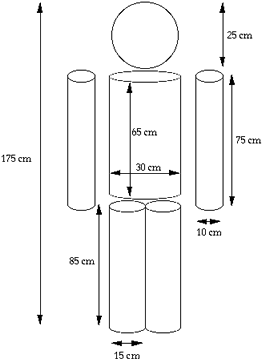
|
Tools - Math 'Plausible Estimation' Estimating for Amazing Facts Tasks, Set #2 (solutions)
Estimates for a Million, Set #1 (solutions)
Estimating for Amazing Facts: Set #2 (solutions) || Set #3 (solutions)
Estimates for the USA, Set #4 (solutions)
Malcolm Swan
Mathematics Education
University of Nottingham
Malcolm.Swan@nottingham.ac.uk
Jim Ridgway
School of Education
University of Durham
Jim.Ridgway@durham.ac.uk
The aim of this assessment is to provide the opportunity for you to:
- develop a chain of reasoning that will enable you to estimate quantities to an appropriate degree of accuracy
- choose suitable units for your estimate
- communicate the assumptions upon which your estimate is based.
|
- Heartbeats
|
How many times does a person's heart beat in a lifetime?
|

|
Solution:
|
Assumptions
- A heart beats about 70 times/minute
- An average life span is about 75 years
|
|
Reasoning
75 years x (70 heart beats/minute) = 75 years x (36,792,000 heart beats/year)
Answer: About 2,800,000,000 beats
(In fact, during the first 10 years of life a person's heartbeat will average nearer 100 beats per minute. This would make the average heartbeat over a lifetime nearer 74 beats per minute).
|
- Crowded Tennis (or football)
|
How many people could comfortably stand on a tennis court? (or, if you prefer, a US football field?)
|

|
Solution:
|
Assumptions
- Dimensions of tennis court = 26 yards x 12 yards (= 24 meters x 11 meters)
- Dimensions of US football field = 120 yards x 53 yards (=110 meters x 50 meters)
- Average dimensions of space taken by person = 1'6" x 1'.
|
|
Reasoning
Each person thus occupies approximately 1.5 square feet = 0.17 square yards.
Thus (26 x 12) ÷ 0.17 = 1,835 people could fit onto a tennis court
or (120 x 53) ÷ 0.17 = 37,411 people could fit onto a US football field.
Answer: Approximately 1,800 people on a tennis court or 37,000 on a football field.
|
- Mummies
|
An unraveled toilet roll is 33 meters, or 100 feet long.
Will one toilet roll be enough to wrap a person?
Describe your reasoning as fully as possible.
|

|
Solution:
|
Assumptions
- The toilet roll is about 5 inches wide.
- The person is 6 feet tall and 2 feet wide.
- We can model the person as a two sided rectangle!
|
|
Reasoning
An estimate for the surface area of a person is thus 2 x 6 x 2 = 24 square feet.
The surface area of the toilet roll is 0.4 x 100 = 40 square feet.
Answer: The toilet roll should easily cover the person.
A 'more accurate estimate' of the surface area of a (slightly shorter) person may be obtained by imagining that the person is made up from cylinders and spheres as shown below.

The person will have a surface area of
| Head |
Body |
Arms |
Legs |
4 x  x 12.52 x 12.52 |
 x 30 x 65 x 30 x 65 |
2 x  x 10 x 75 x 10 x 75 |
2 x  x 15 x 85 x 15 x 85 |
| 1,964 |
6,127 |
4,713 |
8,012 |
| Total = 20,816 |
| ≈ 21,000cm2 or about 22.6 square feet. |
This is a lot of unnecessary hard work for an estimate which is little different.
This is a poor strategy for such a question.
|
- The Train Journey
|
I met Dodge on an Amtrak train in Union Station, Washington, in January of 1993. He came into an empty car and sat beside me, explaining that the car would before long fill up. It did. He didn't know me from Chichikov, nor I him...Two hundred miles of track lie between Union Station and Trenton, where I got off, and over that distance he uttered about forty thousand words. After I left him, I went home and called a friend who teaches Russian literature at Princeton University, and asked her who could help me assess what I had heard,...
|

|
How many words do you think you could speak, at normal conversation speed, during a 200 mile train journey? (Hint: You could start by timing yourself reading the article).
Hence decide if the statement 'he uttered about forty thousand words' is reasonable.
Solution:
|
Assumptions
- A person speaks about 170 words per minute.
- Trains go fast (> 70 mph), but also make stops. An estimate of 60 mph as an average seems reasonable.
|
|
Reasoning
At a rate of 60 mph, traveling 200 miles takes 200 ÷ 60 = 31/3 hours = 200 minutes.
(Quicker: 60 mph = 1 mile per minute, so 200 miles requires 200 minutes.)
At a rate of 170 words per minute, the number of words in 200 minutes is 170 x 200 = 34,000 words, assuming the person talked all the time.
This is not quite 40,000 words.
So, either the person talked a little faster, or the train went slower, or a bit of both.
Answer: I could speak about 34,000 words. The claim appears reasonable.
|
Estimates for a Million, Set #1 (solutions)
Estimating for Amazing Facts: Set #2 (solutions) || Set #3 (solutions)
Estimates for the USA, Set #4 (solutions)

|
